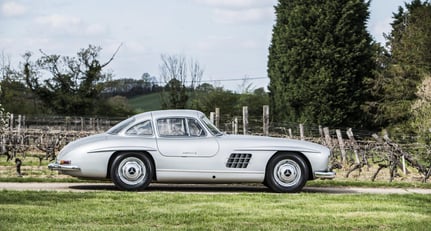1954 Mercedes-Benz 300 SL
Stirling Moss/Denis Jenkinson 1955 Mille Miglia Reconnaissance 'Gullwing'-
Year of manufacture1954
-
Car typeCoupé
-
Chassis number198.040-4500019
-
Engine number198.980-4500003
-
Lot numberLot 26
-
DriveLHD
-
ConditionUsed
-
Number of seats2
-
Location

-
Exterior colourSilver
-
Drivetrain2wd
-
Fuel typePetrol
Description
The Ex-Paris Salon, London Motor Show, 'The Autocar' road test
1954 Mercedes-Benz 300SL "Gullwing" Coupé
Registration no. PLB 23
Chassis no. 198.040-4500019
Engine no. 198.980-4500003
Here we offer this simply outstanding Mercedes-Benz 300SL 'Gullwing' Coupe, which is one of the earliest surviving, and most significant, of all the renowned Stuttgart marque's purebred production-series.
During the mid-1950s these super-sophisticated, 3-litre-engined rocket ships were the fastest road cars that money could buy. Amongst them all the individual 'Gullwing' presented here is chassis serial '4500019' which was the French and international model-launch vehicle displayed by Daimler-Benz at the 1954 Paris Salon de l'Automobile exhibition. It was a late arrival there, its place on the Mercedes-Benz stand having been occupied previously by a Formula 1 W196 model, similar to the ex-Fangio double-Grand Prix-winning example famously sold in our Festival of Speed auction last year.
Denis Jenkinson – 'Motor Sport' magazine's illustrious Continental Correspondent (known universally as 'Jenks' and renowned for his rather acerbic take on high-priced cars) – reported in their November, 1954, issue: "Next door to Jaguar, and displayed in a rather exaggerated manner, was a 300SL Mercedes-Benz coupe fitted with fuel injection as standard and available in France for £5,000. In all major respects identical with the cars raced by Mercedes-Benz, the 300SL was given a slightly more saleable look by having more detail finish to the bodywork. It was displayed in a place of honour on the Mercedes-Benz stand, brilliantly illuminated and surrounded by chromium railings. This was seen on the Monday after the Show opened although the previous few days had seen a Grand Prix Type W196 racing car in the place of honour..."
This same car was then transferred to Mercedes-Benz (GB) Ltd in preparation for taking pride of place upon the marque's display stand at the following London Motor Show, staged in the British capital's vast Earl's Court exhibition centre. John Bolster in 'Autosport' magazine reported: Mercedes-Benz show all their normal models, and in addition they exhibit the much-desired 300SL. This is a very beautiful high-speed coupe, and with its fuel-injection 3-litre engine it is capable of exceeding 150mph. It is quite a practical car, having some luggage space in addition to the two seats. Although the spaceframe (chassis) naturally impedes entry (due to its high paneled and trimmed sills on each side) the gull-wing doors and the folding wheel make this as easy as possible...this is certainly a most exciting car..."
After its two starring appearances in Paris and London, '4500019' now offered here was UK road-registered under the serial 'PLB 23'- which it retains today –and served as the press road test and demonstration vehicle maintained by Mercedes-Benz GB, of Mercedes-Benz House, 58 Camberwell New Road, London SE5. They loaned it to 'The Autocar' magazine's highly-experienced road testing staff for full evaluation, the resultant report being published in the magazine's March 25, 1955, edition.
In part the report reads: "The 300SL, in addition to being very fast, is also very safe, and a brief description of the mechanical layout will point out some of the reasons why. The chassis frame is built up of a number of steel tubes of small diameter with two main engine cross-members. Suspension at the front is by coil springs and double wishbones, and the usual Mercedes independent rear suspension of coil springs and swinging half-axles is employed. The 3-litre six-cylinder overhead camshaft engine lies at an angle in the frame to assist in keeping the overall height down, and one of its most interesting features is the use of fuel injection. The light-alloy body structure is fabricated separately from the chassis, and the two combine to make what is without doubt a most astonishing car."
They described 'PLB 23' offered here as "...docile and tractable in dense city traffic...its true place is outside built-up areas, where it can be allowed to come into its own. After it has trickled along in third and top gears, the time eventually arrives when the driver is able to see the opportunity in front of him, and second gear can be selected, so that the car really comes alive.
"For a passenger who has not travelled in the 300SL before the effect is electrifying....(the passenger) receives at first a mild pressing back into the seat, and then, as the power comes in between 3,500 and 4,000rpm, he feels as though he is being rocketed through space. Up to 70mph is available in second gear...in the indirect gears, and indeed in top, the acceleration of this unusual car is indeed remarkable. Gradients, of course, have no meaning except to add to the exhilaration of driving the car...hump-back bridges have to be treated with real respect, as it is only by keeping a wary eye on the instruments that the driver is really sure at what speed he is travelling..."
They found that 'PLB 23' would accelerate from 0-60mph in 8.8secs, 0-100mph in 21secs and 0-120mph in 56.4secs – stupendous figures by the standards of 1954, sixty long years ago. They also recorded maxim speeds through the gears as 44mph in first, 70mph in second, 98mph in third and a best of 135mph in top (150mph-plus plainly being contemporary manufacturer's hype – ask any Jaguar owner...).
The test team further commented upon finding "The ride is by no means harsh; on one 400-mile journey a small child was able to sleep curled-up on what is essentially the luggage space behind the seats.
"When cornering at the speed of other traffic the 300SL goes round firmly on the proverbial rails. There are but two turns lock-to-lock and the driver is never conscious of actually turning the wheel to direct the car. It is reminiscent of a fast motor-cycle, which is steered more by leaning the body than by actual movement of the handlebars. When taking open, very fast swerves the driver can start to guide – this is the operative word rather than steer – the car round just before he enters the corner and then, using the throttle, make the 300SL come out on the straight in a beautiful movement. .."
In parallel, 'PLB 23' returned fuel consumption figures of 18.4mpg for the 746 miles covered during 'The Autocar' team's test period. All this for the premium UK price in period of no less than £4,392 15s 10d (including taxes).
During the month of April, 1955, meanwhile, the Mercedes-Benz Rennabteilung and works team was fully engaged in reconnaissance to prepare its crews, mechanics and engineers for the debut of the parallel 300SLR sports-racing cars in the world's most prestigious public road race, the Italian Mille Miglia.
Included in the extensive documentation file accompany 'PLB 23' is a letter from Sir Stirling Moss confirming his use of the car during that process. He was accompanied there by his factory team navigator – none other than 'Jenks' of 'Motor Sport' who was in fact 1949 World Champion Motorcycle Sidecar racing passenger, Denis Jenkinson. Although works team records concerning the 300SLs used during that reconnaissance period are non-specific about chassis identities, Sir Stirling's recollection that the Mercedes-Benz GB demonstrator was sent out in this manner connects '4500019' here with his and Jenks's stupendous subsequent victory. Indeed, that 300SLR win in the 1955 1,000-mile Mille Miglia round-Italy road race involved one of the most illustrious and legendary drives in all motor sporting history...
World-renowned in period – and much coveted by collectors today – the 3-litre 6-cylinder fuel-injected Mercedes-Benz 300SL 'Gullwing' Coupe was, from 1955-57, the world's fastest production supercar.
When Mercedes-Benz set out to add the Sports Car World Championship to its Formula 1 World title successes in 1955, the opening race of the series was the astounding Mille Miglia – one lap of a thousand-mile public road course starting and finishing in the northern city of Brescia.
On May 1, 1955, the new Mercedes-Benz team of open-cockpit 300SLR sports-prototype cars simply destroyed their Ferrari and Maserati opposition to dominate the Mille Miglia, scoring an historic 1-2 triumph, with Stirling Moss/Denis Jenkinson winning from reigning Formula 1 World Champion Juan Manuel Fangio. Moss credited much of his extraordinary victory to navigator 'Jenks' who for the entire 1,000 miles had been able to warn Stirling "...of corners that could kill us, and of opportunities to stay flat-out and so save time".
Their knowledge had been accumulated from painstaking reconnaissance runs around the 1,000-mile course.
On April 1, 1955, they had driven their first 300SL 'issue car'– not '4500019' now offered here - out of Brescia – where the Mille Miglia would start a month later – in company with young German team-mate Hans Herrmann in the first of the full-race 300SLR open-cockpit cars. 'Jenks's diary for the day records: "Left Brescia 6.30am in 300SL – Herrmann in 300SLR. Averaging 78mph – crash with Army lorry at Forli. All day sorting things out with M-B technicians. Home in 220A" – Mercedes saloon car – "...by 1 am."
On Monday April 18 the duo again left Brescia in a replacement Gullwing – possibly this car - "7am in SL and drove to Florence, 1500 kilometres. Terrific fun helping driving on blind corners...Fangio passed in Verona – Herrmann later in SLRs...". Next day "...Left 9am and another good drive back to Brescia". On the 20th Moss/Jenkinson got their chance in the open SLR only for its crankshaft to break at Rimini, while "Fangio had broken SL...".
Jenks's diary entry for May 1, 1955, is astonishingly succinct. It simply reads: "Up at 6am for race day. WE WON. Party in evening with Mercedes-Benz. Bed at 1am". That was, for the team and for its all-British crew mission accomplished.












